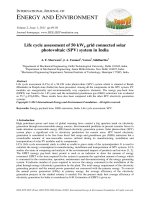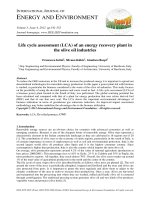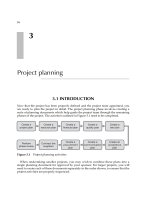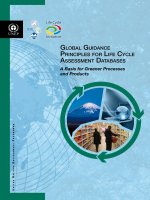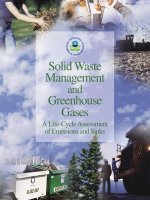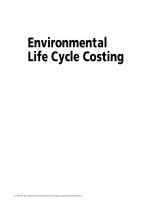Environmental life cycle assessment
Bạn đang xem bản rút gọn của tài liệu. Xem và tải ngay bản đầy đủ của tài liệu tại đây (15.02 MB, 330 trang )
ENVIRONMENTAL
LIFE CYCLE
ASSESSMENT
ENVIRONMENTAL
LIFE CYCLE
ASSESSMENT
Olivier Jolliet
Myriam Saadé-Sbeih
Shanna Shaked
Alexandre Jolliet
Pierre Crettaz
Boca Raton London New York
CRC Press is an imprint of the
Taylor & Francis Group, an informa business
CRC Press
Taylor & Francis Group
6000 Broken Sound Parkway NW, Suite 300
Boca Raton, FL 33487-2742
© 2016 by Taylor & Francis Group, LLC
CRC Press is an imprint of Taylor & Francis Group, an Informa business
No claim to original U.S. Government works
Version Date: 20151012
International Standard Book Number-13: 978-1-4398-8770-7 (eBook - PDF)
This book contains information obtained from authentic and highly regarded sources. Reasonable
efforts have been made to publish reliable data and information, but the author and publisher cannot
assume responsibility for the validity of all materials or the consequences of their use. The authors and
publishers have attempted to trace the copyright holders of all material reproduced in this publication
and apologize to copyright holders if permission to publish in this form has not been obtained. If any
copyright material has not been acknowledged please write and let us know so we may rectify in any
future reprint.
Except as permitted under U.S. Copyright Law, no part of this book may be reprinted, reproduced,
transmitted, or utilized in any form by any electronic, mechanical, or other means, now known or
hereafter invented, including photocopying, microfilming, and recording, or in any information storage or retrieval system, without written permission from the publishers.
For permission to photocopy or use material electronically from this work, please access www.copyright.com ( or contact the Copyright Clearance Center, Inc. (CCC), 222
Rosewood Drive, Danvers, MA 01923, 978-750-8400. CCC is a not-for-profit organization that provides licenses and registration for a variety of users. For organizations that have been granted a photocopy license by the CCC, a separate system of payment has been arranged.
Trademark Notice: Product or corporate names may be trademarks or registered trademarks, and are
used only for identification and explanation without intent to infringe.
Visit the Taylor & Francis Web site at
and the CRC Press Web site at
Contents
Foreword................................................................................................................... xv
Preface....................................................................................................................xvii
Authors.....................................................................................................................xix
Symbols....................................................................................................................xxi
Acronyms................................................................................................................xxv
Chapter 1 Introduction........................................................................................... 1
Olivier Jolliet, Gabrielle Soucy, Shanna Shaked,
Myriam Saadé-Sbeih, and Pierre Crettaz
1.1 Priorities for the Environment.................................................... 1
1.2 Critical Approach, Objectives, and Book Structure...................2
1.2.1 Being Critical................................................................ 2
1.2.2Objectives......................................................................2
1.2.3 Book Structure..............................................................2
1.3 Background and Standardization...............................................2
1.4 Use of the LCA Tool................................................................... 5
Chapter 2 General Principles of Life Cycle Assessment....................................... 7
Olivier Jolliet, Gabrielle Soucy, Shanna Shaked,
Myriam Saadé-Sbeih, and Pierre Crettaz
2.1 Definition of the Four LCA Phases............................................ 7
2.2 Performing an LCA.................................................................... 9
2.2.1 Iterative Method............................................................ 9
2.2.2 Calculations by Hand and Using Software...................9
2.3 Characteristics Specific to LCA and Comparison with
Other Environmental Analysis Tools....................................... 10
2.3.1 Characteristics Specific to Life Cycle Assessment..... 10
2.3.2 Comparison with Other Environmental Analysis
Tools............................................................................ 10
2.3.2.1 Comparison between Substance Flow
Analysis and LCA........................................ 11
2.3.2.2 Comparison between Environmental
Impact Assessment and LCA...................... 13
2.3.2.3 Comparison between Risk Assessment
and LCA.................................................... 13
2.3.2.4 Comparison between Material Flow
Analysis and LCA........................................ 14
2.3.2.5 Comparison between Carbon
Footprint and LCA.................................... 14
v
vi
Contents
2.4
Simple Application: Comparing Different Types of Cups....... 14
2.4.1 Goal and Scope Definition of Cup Case Study........... 14
2.4.2 Inventory Analysis of Cup Case Study....................... 16
2.4.3 Impact Assessment of Cup Case Study....................... 16
2.4.4 Interpretation of Cup Case Study................................ 19
2.4.5 Conclusions of Cup Case Study.................................. 19
Exercises..............................................................................................20
Chapter 3 Goal and System Definition................................................................ 23
Olivier Jolliet, Gabrielle Soucy, Shanna Shaked,
Myriam Saadé-Sbeih, and Pierre Crettaz
3.1Objectives................................................................................. 23
3.1.1 Goal: Type of Application, Intended Audience,
and Stakeholders......................................................... 23
3.1.2Scope...........................................................................24
3.2 System Function.......................................................................26
3.3 Functional Unit and Reference Flow........................................ 27
3.3.1Definitions................................................................... 27
3.3.2 Critical Choice of a Functional Unit: Popcorn
as a Packaging Material..............................................28
3.3.3 Electric Light Bulbs: Setting Up the Life Cycle
Assessment.................................................................. 30
3.3.4 Functional Unit and Reference Flows: A Common
Basis for Both Environmental and Cost Analyses.........31
3.3.4.1 Electric Light Bulbs: Life Cycle Costs........ 31
3.3.5 Multifunctional Products............................................ 32
3.4 System Definition.....................................................................34
3.4.1 Principles of System Modeling...................................34
3.4.2Flowchart..................................................................... 36
3.4.3 Description of Scenarios............................................. 37
3.5 System Boundaries................................................................... 37
3.5.1 Principles of System Boundaries................................ 37
3.5.2 Main Considered Processes........................................ 38
3.5.3 Importance of System Boundaries: Comparing a
Fast-Food and a Traditional Restaurant...................... 38
3.5.4 Rules to Define System Boundaries............................40
Exercises..............................................................................................44
Chapter 4 Inventory Analysis of Emissions and Extractions............................... 47
4.1
4.2
Principles of Inventory Analysis.............................................. 48
4.1.1 Comparison of Process-Based Inventory with
Input/Output Inventory.............................................. 48
4.1.2Definitions................................................................... 48
4.1.3 Problem of Aggregation over Time and Space........... 48
Process-Based Calculation of the Inventory............................ 49
vii
Contents
4.2.1
4.3
4.4
Step-by-Step Procedure for Process-Based
Inventory Analysis...................................................... 49
4.2.2 Calculation and Assessment of Energy
Consumption and CO2 Emissions............................... 50
4.2.2.1 Assessment of Energy Consumption........... 50
4.2.2.2 Energy Consumption of Electric Light
Bulbs............................................................ 54
4.2.2.3 Assessment of CO2 Emissions..................... 54
4.2.2.4 Checking the Ratio of CO2 Emitted per
Megajoule of Nonrenewable Primary
Energy.......................................................... 55
4.2.2.5CO2 Assessment of Electric Light Bulbs..... 56
4.2.2.6 Classifying Products.................................... 56
4.2.3 Example of Process-Based Life Cycle Inventory:
Front-End Panel of an Automobile.............................. 57
4.2.4 Generalization and Process Matrix Approach............ 62
Inventory Databases for Process-Based Approach...................64
4.3.1 Existing Databases......................................................64
4.3.2Ecoinvent.....................................................................66
4.3.2.1 The Project and Its Products........................66
4.3.2.2 Description of the Ecoinvent 2.2 Database....67
4.3.2.3 Principal Characteristics of the Database.... 67
4.3.2.4 New Features of Ecoinvent 3.1.................... 69
4.3.2.5 Tips for Using Ecoinvent Database............. 70
4.3.3 Data Quality and Uncertainties................................... 71
Input–Output Approach for Extractions and Emissions
Inventory................................................................................... 72
4.4.1 Input–Output Calculations.......................................... 72
4.4.2 I/O Database................................................................ 73
4.4.2.1 Determining Economic I/O Matrix............. 74
4.4.2.2 Determining I/O Environmental Matrix..... 74
4.4.2.3 I/O Country-Specific Databases.................. 76
4.4.2.4 I/O Multiregional Databases........................ 78
4.4.3 Example of Input–Output LCA: Aluminum
Front-End Panel of Automobile................................... 78
4.4.3.1 Functional Unit, Reference Flow, and
Final Demand.............................................. 78
4.4.3.2 Economic Data and Determination of
the I/O Economic Matrix............................ 79
4.4.3.3 Environmental Data and Determination
of the Environmental Matrix........................80
4.4.3.4 Calculation of Total Monetary Output
per Functional Unit...................................... 81
4.4.3.5 Primary Energy and CO2 Emissions
per Functional Unit over the Supply
Chain of Front-End Panel and Gasoline...... 81
viii
Contents
4.4.3.6CO2 Emissions during Usage Stage............. 82
4.4.3.7 Comparison with Process LCA................... 82
4.4.3.8 Analysis of Impacts by Supply Chain Tier.... 82
4.4.4 Advantages and Limitations of I/O Approach............ 83
4.4.5 Combined Hybrid Use of Process and I/O
Approaches..................................................................84
4.4.5.1 Level 1: Verification of System Boundaries... 84
4.4.5.2 Level 2: Impacts of Services........................ 85
4.4.5.3 Level 3: Hybrid Approach........................... 85
4.5 Coproducts and Allocation....................................................... 85
4.5.1 Issues When Multiple Products Are Made by
One System.................................................................. 85
4.5.2 Product Categories and Allocation............................. 85
4.5.2.1Coproducts................................................... 85
4.5.2.2 Waste (to Be Disposed Of).......................... 86
4.5.2.3 Recycled Waste and By-Products with
Low Economic Value.................................. 86
4.5.3 Allocation Methods for Coproducts............................ 87
4.5.3.1 Allocation Procedure from ISO 14044........ 87
4.5.3.2 (a) Avoiding Allocation................................ 88
4.5.3.3 Process Subdivision..................................... 88
4.5.3.4 System Expansion........................................ 89
4.5.3.5 (b) Physical Allocation................................92
4.5.3.6 (b1) Marginal Variation...............................92
4.5.3.7 (b2) Representative Parameter in the
Case of a Common Function....................... 93
4.5.3.8 (b3) Property Reflecting a Causal
Physical Relation.........................................94
4.5.3.9 (c) Economic or Functional Causality......... 95
4.5.4 Sensitivity Analysis and Comparison of
Different Methods....................................................... 95
4.5.5 Open-Loop Recycling of Waste-Like
Coproducts: Financial Allocation...............................96
4.5.5.1Principle.......................................................96
4.5.5.2 Example: The Case of Manure....................96
4.5.5.3 Case Study Application as Example............97
4.5.6 Summary of Allocation...............................................97
Exercises............................................................................................ 100
Chapter 5 Life Cycle Impact Assessment.......................................................... 105
Olivier Jolliet, Shanna Shaked, Myriam Saadé-Sbeih,
Cécile Bulle, Alexandre Jolliet, and Pierre Crettaz
5.1 Purpose of Impact Assessment............................................... 105
5.2 Principles of Impact Assessment............................................ 106
5.2.1 General Principles..................................................... 106
ix
Contents
5.2.2
5.3
5.4
5.5
5.6
Methodological Framework: Midpoint and
Damage Categories................................................... 107
5.2.3 Steps of Impact Assessment...................................... 108
5.2.3.1Classification.............................................. 109
5.2.3.2 Midpoint Characterization......................... 109
5.2.3.3 Damage Characterization: Getting
from Midpoint to Damage......................... 110
5.2.3.4 Optional Steps: Normalization,
Grouping, and Weighting........................... 112
5.2.4 Uncertainties and Use of Evaluation Methods of
Impact........................................................................ 115
Application Example of the IMPACT World+ Method:
Front-End Panel of an Automobile......................................... 115
5.3.1 Analysis of Inventory Results................................... 115
5.3.2 General IMPACT World+ Framework and
Classification............................................................. 116
5.3.3 Midpoint Characterization of Front-End Panel
Scenarios................................................................... 117
5.3.4 Damage Characterization of Front-End Panel
Scenarios................................................................... 118
5.3.5 Normalization of Front-End Panel Scenarios........... 120
5.3.6 Weighting of Impacts for Front-End Panel............... 121
Overview of the Main Impact Assessment Methods............. 121
Description of the Main Impact Assessment Methods.......... 125
5.5.1 Critical Volumes: An Outdated Approach................ 125
5.5.2 EPS 2000d Method................................................... 126
5.5.3 Eco-indicator 99........................................................ 126
5.5.4 Dutch Handbook on LCA......................................... 127
5.5.4.1 Classification and Characterization........... 127
5.5.4.2 Normalization and Evaluation................... 128
5.5.5 Ecological Scarcity Method...................................... 128
5.5.6 TRACI, the U.S. EPA Method.................................. 129
5.5.7 IMPACT 2002+......................................................... 130
5.5.7.1 Human Health............................................ 130
5.5.7.2 Ecosystem Quality..................................... 131
5.5.7.3 Climate Change......................................... 131
5.5.7.4Resources................................................... 131
5.5.8 LIME: The Japanese Method.................................... 131
5.5.9 ReCiPe 2008.............................................................. 133
5.5.10 New European Method............................................. 135
5.5.11 IMPACT World+....................................................... 138
5.5.12USEtox...................................................................... 140
Future Developments.............................................................. 142
5.6.1 Further Spatial Differentiation.................................. 142
5.6.2 Methods for Higher Resolution Life Cycle
Impact Assessment.................................................... 142
x
Contents
5.6.3
5.6.4
Substances and Impact Categories............................ 143
Harmonization of Life Cycle Impact
Assessment: The Life Cycle Initiative Flagship
Project for LCIA Global Guidance........................... 143
Exercises............................................................................................ 144
Chapter 6 Interpretation..................................................................................... 149
6.1
6.2
6.3
6.4
6.5
Interpret! Interpret! Interpret!................................................ 149
Identification of Action Priorities........................................... 150
Interpretation Example: Desktop versus Laptop Computer.....150
6.3.1 Goal and Scope Definition........................................ 151
6.3.1.1 Definition of System Boundaries............... 151
6.3.2Inventory................................................................... 151
6.3.3 Impact Assessment.................................................... 154
6.3.4 Assessment Based on Updated Data and Method..... 155
Quality Control....................................................................... 156
6.4.1 Controls at Every Phase of LCA............................... 157
6.4.1.1 Goal and Scope Definition: System
Modeling.................................................... 157
6.4.1.2 Inventory Analysis: Unit Control............... 157
6.4.1.3 Inventory Analysis: Mass Balance............ 157
6.4.1.4 Inventory Analysis: Energy and CO2
Balances “by Hand”................................... 157
6.4.1.5 Inventory Analysis: Comparing CO2
and Energy................................................. 158
6.4.1.6 Inventory Analysis: Comparison of
Inventory Results with Other Studies........ 158
6.4.1.7 Impact Assessment: Toxicity Check.......... 158
6.4.1.8 Impact Assessment: Rules for Proper
Use of LCA Software................................ 158
6.4.1.9 Project Management: Recommended
Use of Spreadsheets................................... 159
6.4.1.10 Project Management: Rules for Project
Documentation........................................... 159
6.4.2 Critical or Peer Review to Check for a
Comprehensive and Consistent Study....................... 159
Overview of Uncertainty, Variability, and Data Quality........ 160
6.5.1 General Principles and Types of Uncertainty........... 160
6.5.1.1 Uncertainties in the Four LCA Phases...... 160
6.5.1.2 Parameter Uncertainty............................... 160
6.5.2 Data Quality and Uncertainty Distribution for
Input Data.................................................................. 163
6.5.2.1 Probability Distribution of an
Individual Variable.................................... 163
xi
Contents
6.5.2.2 Quality Indicators...................................... 164
Assessment and Mitigation of Uncertainty............................ 166
6.6.1 Semiquantitative Approaches and Expert
Judgment................................................................. 166
6.6.1.1 LCA Standardization................................. 166
6.6.1.2 Expert Judgment and Default
Uncertainty Estimates............................... 169
6.6.2 Sensitivity Study........................................................ 169
6.6.2.1 Scenario Analysis...................................... 170
6.6.3 Model Improvement Strategies................................. 170
6.6.3.1 Nonlinear Modeling.................................. 170
6.6.3.2 Dynamic or Spatialized Modeling............ 170
6.6.4 Monte Carlo Analysis and Taylor Series
Expansion in LCA..................................................... 171
6.6.4.1 Monte Carlo............................................... 171
6.6.4.2 Analytical Uncertainty Propagation
Using Taylor Series Expansion.................. 173
6.6.5 Application of Monte Carlo and Taylor Series to
Case Study................................................................. 174
6.6.6 Comparison to Measurements and Additional
Data Collection.......................................................... 178
6.7 LCA Software......................................................................... 179
6.8 Environmental Evaluation and Socioeconomic
Evaluation........................................................................ 180
6.8.1 Life Cycle Costing..................................................... 180
6.8.1.1Introduction............................................... 180
6.8.1.2 Example: Sewage Sludge Treatment
and Transport............................................. 182
6.8.2 Cost Internalization................................................... 183
6.8.3 Cost-Environmental Performance Representation.....185
6.8.4 Rebound Effect.......................................................... 187
6.8.5 Accounting for Social Aspects.................................. 188
Exercises............................................................................................ 191
6.6
Chapter 7 Conclusions and Key Points.............................................................. 199
7.1
7.2
7.3
Key Points of a Life Cycle Assessment.................................. 199
7.1.1 Goal and System Definition...................................... 199
7.1.2Inventory................................................................... 201
7.1.3 Impact Assessment....................................................202
7.1.4Interpretation............................................................. 203
Limitations of an LCA........................................................... 203
Potential Applications of an LCA..........................................205
7.3.1 Overview of LCA Publications.................................205
7.3.2 Application to Ecodesign..........................................206
xii
Contents
7.3.3
7.3.4
7.3.5
7.3.6
7.3.7
Application to Product Comparisons........................206
Application to Long-Term Decision-Making............207
Application to Different Types of Products..............207
LCA: A Tool for Life Cycle Thinking......................207
Example of Life Cycle Management of a
Company...............................................................208
Exercises............................................................................................ 210
Chapter 8 LCA through Example from A to Z: Treating Urban Sewage
Sludge................................................................................................ 211
Gregory Houillon, Olivier Jolliet, Shanna Shaked, and
Myriam Saadé-Sbeih
8.1Introduction............................................................................ 211
8.1.1 Overview of Case Study Application:
Urban Wastewater and Sewage Sludge Treatment.... 211
8.1.1.1 Urban Wastewater Treatment.................... 211
8.1.1.2 Urban Sewage Sludge Treatment............... 212
8.1.2 Review of Environmental Assessment of
Wastewater Sludge: Treatments and Key
Challenges................................................................. 212
8.2 Goal and Scope Definition..................................................... 214
8.2.1Objectives.................................................................. 214
8.2.2 Functional Unit.......................................................... 214
8.2.3 System Definition...................................................... 214
8.2.3.1 Description of Studied Scenarios.............. 214
8.2.3.2 System Boundaries and Flow Chart.......... 216
8.2.4 System Modeling: Reference Flows, Direct
Emissions, Substitutions, and Data Quality.............. 218
8.2.4.1 Direct Emissions and Micropollutant
Transfers.................................................... 219
8.2.4.2Substitutions............................................... 219
8.2.4.3 Data Sources and Quality.......................... 220
8.3 Inventory Results....................................................................224
8.3.1 Intermediary Flows and Detailed Calculation of
the Energy Consumption of the INCI d Scenario.....224
8.3.2 Overall Inventory Results.......................................... 225
8.4 Impact Assessment................................................................. 225
8.4.1 Energy Consumption................................................. 232
8.4.2 Global Warming........................................................ 235
8.4.3 Human Toxicity and Ecotoxicity............................... 235
8.5 Interpretation and Recommendations.................................... 237
8.5.1 Reference Scenarios.................................................. 237
8.5.1.1 Agricultural Landspreading of Limed
Pasty Sludge.......................................... 237
xiii
Contents
8.5.2
8.5.3
8.5.1.2 Incineration in Fluidized Bed of Pasty
Sludge........................................................ 238
8.5.1.3 Wet Oxidation of Liquid Sludge................ 238
8.5.1.4 Pyrolysis of Dried Sludge.......................... 238
8.5.1.5 Incineration of Dried Sludge in Cement
Kilns.......................................................... 238
8.5.1.6 Landfilling of Limed Pasty Sludge............ 239
Sensitivity Analyses.................................................. 239
8.5.2.1 Transport Distances................................... 239
8.5.2.2 Residue Stabilization................................. 239
Recommendations and Outlook................................240
Chapter 9 Metacomparison of the Life Cycle Environmental Impacts of
Bio-Based Products........................................................................... 243
Gregory Houillon, Josef Kaenzig, Jinglan Hong, Andrew
Henderson, and Olivier Jolliet
9.1Introduction............................................................................ 243
9.2 Methods: Meta-Analysis of LCA Studies............................... 245
9.2.1 Overview of LCA Studies......................................... 245
9.2.2 Analysis of Quality and Selection of Studies
Analyzed in Detail....................................................246
9.2.3 Quantitative Comparison of Various Supply
Chains across Studies................................................246
9.2.3.1 (A) Absolute Gain per Hectare of
Cultivated Land.........................................248
9.2.3.2 (B) Gain Relative to the Substituted
Part.........................................................249
9.3 Results and Discussion........................................................... 249
9.3.1 Comparison of the Environmental Impacts of
Bio-Based Products................................................... 249
9.3.1.1 Comparison across the 10 Categories
of Bio-Based Products............................... 249
9.3.1.2Agrimaterials............................................. 252
9.3.1.3Biopolymers............................................... 253
9.3.1.4 Agricultural and Forest Biomass............... 253
9.3.1.5Biofuels...................................................... 253
9.3.1.6 Other Uses................................................. 253
9.3.2 Key Parameters and Comparative Metrics................ 254
9.4Conclusions............................................................................. 254
9.4.1 Comparison of Bioproducts....................................... 254
9.4.2 Plant Resource Supply Chains.................................. 256
9.4.3 Improvement of LCA Knowledge............................. 257
9.4.4 Methodological Outlook............................................ 257
xiv
Contents
Appendix I............................................................................................................. 259
Appendix II............................................................................................................ 261
Appendix III.......................................................................................................... 265
Appendix IV.......................................................................................................... 271
Glossary................................................................................................................. 275
References.............................................................................................................. 283
Foreword
The pressure that our growing human population is putting on nature and our common global environment is becoming increasingly serious and visible not just in
the way that we are impacting the global climate but also in our use of land, water,
and nonrenewable resources, our emissions of thousands of chemicals with potential
toxic effects on humans and ecosystems, and our contribution to regional environmental problems like acidification and photochemical air pollution. Our responsibility as citizens, enterprises, and political decision-makers to face the challenge
and seriously change the way in which we interact with the environment, through
our consumption of products and services, becomes more evident every year.
Communication about sustainability is widespread and many claims are made about
environmental sustainability, but few are substantiated. The field suffers from a lack
of factual knowledge about the impacts caused by our use of products and services
and about what matters and what is insignificant, and decisions are often made on a
poorly informed basis.
We need to be able to put numbers on environmental sustainability in order to
support a more qualified debate about what the most sustainable choices are among
alternative solutions. Life cycle assessment (LCA) is a central tool to this end. With
its system perspective, considering the entire life cycle from the cradle to the grave
of the product or technology, and with its broad coverage of environmental impacts,
it enables us to reveal and avoid problem shifting in the value chain and between
different environmental impacts. It offers us a widely encompassing insight and quantitative information on the environmental sustainability performance of the solutions
that we use it to assess. This is why LCA is today the analytical backbone in the
European Commission’s Strategy for Sustainable Consumption and Production and
why it is widely disseminated and used in sustainable building initiatives, sustainability assessment of biofuels and biomaterials, environmental product declarations
and ecolabeling, and not least in product development in thousands of companies
who use it to focus their ecodesign activities and support decision-making in the
development of new and improved product generations.
The successful dissemination of LCA and life cycle–based approaches in many
parts of the world is accompanied by a growing demand for skilled professionals
who are trained in the use of this methodology, and there is therefore a need for good
teaching materials in LCA. I find it difficult to think of a team more qualified to
fill this need than that of Professor Olivier Jolliet from the University of Michigan.
Professor Jolliet has his professional roots in the European history of LCA method
development, where he was involved in research and teaching in the strong Swiss
LCA environment already in the early 1990s. During the last decade, he has been
an active member of the North American LCA environment, and he has trained
hundreds of students over the years. He has played a central role in the international
community around life cycle impact assessment method development with a consistent focus on improving the state of the art and disseminating good LCA practice.
Together with his team, he has developed several full life cycle impact assessment
xv
xvi
Foreword
methods over the years, and he has led various method development working groups
under the Society of Environmental Toxicology and Chemistry (SETAC) and the
United Nations Environment Programme (UNEP)-SETAC Life Cycle Initiative,
which he was instrumental in launching. He is a member of the core team behind the
USEtox model for assessment of human and ecotoxicity in LCA and currently leads
the UNEP-SETAC Life Cycle Initiative’s flagship project on enhancing life cycle
impact assessment.
Professor Jolliet is an excellent presenter and pedagogue, and together with
his team of coauthors, he has managed to distill these skills into the chapters of
this textbook, which in its structure follows the stages of the life cycle assessment
methodology. There is a chapter for each stage, offering a thorough introduction to
the elements to be performed, accompanied by concrete examples. The book also
offers two chapters illustrating the application of LCA to comparative assessments
of wastewater treatment technologies and of biobased products. It is a concise and
pedagogic book that will serve well for the reader who wants to understand the
essentials of LCA, and I give it my strong recommendation.
Michael Hauschild
Professor in Quantitative Sustainability Assessment
Technical University of Denmark
Preface
How can we make sustainability decisions that account for the big picture? Life cycle
assessment (LCA) provides such a framework that has been widely adopted in the
past decade by governments to inform policy and by proactive companies to identify
their most important environmental problems and reduce corresponding impacts.
Building on 25 years of LCA teaching with more than a thousand students worldwide, this textbook meets the needs of professionals and students around the world
to teach themselves good practice in LCA and to discover the beauty and limitations
of this systems approach.
Several features make LCA a unique sustainability tool worth learning about and
applying to many of today’s problems:
• First, LCA, in contrast to a regulatory-oriented method, is primarily a voluntary tool that stimulates leading companies and governments to identify
their strengths and weaknesses, go beyond basic assumptions and counterproductive opposition between stakeholders, and ultimately find innovative
and sustainable solutions toward product and behavior improvement.
• The progress made in LCA since the 1990s has been striking, both in terms
of data availability and the scientific quality of impact assessment methods.
While the rate of development and innovation will continue to be high in
the coming years, LCA has reached a level of maturity such that its studies
and approaches are regularly published in the best scientific journal of the
fields.
• Most of all, LCA education is fun, because the learners come from a
wide range of backgrounds and interests, with one common perspective:
approaching sustainability through systems thinking. The beauty of LCA
is that despite the 25 years of LCA research, development, and practice,
every new study brings its surprises and unexpected results that broaden
our understanding.
Our hope and expectation is that this book will constitute the next step toward an
open community of LCA learners and teachers who can further share their experiences and lessons.
Additional material is available from the CRC Press website: and the Teaching LCA website: http://
www.teachinglca.org.
xvii
Authors
Pierre Crettaz earned his PhD in environmental engineering at the Swiss Federal
Institute of Technology in Lausanne in 2000. Between 2000 and 2005, he worked as
a senior scientist at the Swiss Federal Office of Public Health and was responsible for
the registration of pesticides with respect to their human health effects. He obtained
his MSc in applied toxicology at the University of Surrey in Guildford.
He is currently the head of the biocides section at the Swiss Federal Office of
Public Health. He represents Switzerland in different international committees on
biocides (European Chemicals Agency, Organisation for Economic Co-operation
and Development) and is responsible for the risk assessment of biocidal products
such as insecticides, rodenticides, repellents, and disinfectants. Risk management
and communication, as well as the efficacy of biocide evaluation, are also part of his
key activities.
Alexandre Jolliet is an undergraduate student in the College of Literature, Science,
and the Arts at the University of Michigan, where he is studying political science
and philosophy with specializations in political economy and development, political philosophy, and ethics. He spends his summers preparing and teaching courses
to Spanish secondary school students preparing for their Cambridge English First
Certificate in English (FCE) exams at English Summer International Schools in
Tarragona, Spain.
Olivier Jolliet is a full professor in life cycle impact and risk modeling at the
Department of Environmental Health Sciences in the School of Public Health,
University of Michigan. He is also one of the founders of Quantis-International,
which provides life cycle assessment (LCA) expertise to companies and governments.
His teaching and research aim to (a) enable LCA learners to understand and critically assess the strengths and limitations of an LCA; (b) compare the life cycle risks
and benefits of consumer products, foods, and emerging technologies; and (c) model
and screen population exposure, intake fractions, and pharmacokinetics of emerging chemicals. He coinitiated the UNEP/SETAC Life Cycle Initiative, a joint initiative of the United Nation Environment Program and the Society for Environmental
Toxicology and Chemistry. Dr. Jolliet has been one of the pioneers in applying LCA
to food sustainability since the early 1990s, and he has developed comprehensive
Life Cycle Impact Assessment Methods, such as the IMPACT2002 method. He is
one of the developers of USEtox, the UNEP-SETAC model for comparative assessment of chemicals, and is presently developing an extended method to assess the
near-field exposure to chemicals in consumer products. Dr. Jolliet has authored or
coauthored 150 peer-reviewed publications and book chapters. He has given more
than 40 LCA-related master courses and 20 short courses for professionals, and he
has been a primary advisor for 15 PhD students and more than 50 Master’s students.
xix
xx
Authors
Myriam Saadé-Sbeih earned her PhD in environmental sciences from the University
of Lausanne, Switzerland, in 2011, after working for 2 years in the Life Cycle System
group of Professor Jolliet at the Swiss Federal Institute of Technology, Lausanne.
She is currently a Research Fellow at the Graduate Institute of International and
Development Studies in Geneva, Switzerland, and since 2012 has been the scientific coordinator of a research program on the transboundary Orontes River basin,
funded by the Swiss Development and Cooperation Agency. Her research focuses on
human–hydrosystem coevolution in uncertain contexts, especially in the Middle East.
She is a Swiss expert for the United Nations Convention to Combat Desertification
(UNCCD).
Shanna Shaked earned her PhD in applied physics from the University of Michigan
in 2011 after receiving her BS and BA in physics, astronomy, and mathematics from
the University of Arizona in 2002. She also received her MA in teaching from Ithaca
College in 2013. She is a coauthor of peer-reviewed publications in journals such
as Environmental Science and Technology and International Journal of Life Cycle
Assessment, and she has presented her life cycle assessment research on modeling
global impacts of products at numerous international conferences, including as an
invited member of a panel discussion and as chair of a special session on regionalization in LCA. She also coauthored a chapter on global life cycle impacts in the 2011
Enyclopedia of Environmental Health.
She is currently a lecturer in the Departments of Physics & Astronomy and
Environmental Science at the University of California, Los Angeles. She serves
on the University of California, Los Angeles Physical Sciences Undergraduate
Education Committee to revise and improve undergraduate teaching using evidencebased techniques.
She is passionate about using education to help equalize opportunities by making
quality education available to all and by helping more people realize and assess the
global impacts of their actions.
Symbols
aij
A
ãij
Ã
AE
bkj
B
b%ki
%
B
c
C
CDALY
CFi
CFd,idamage
midpoint
CFm,i
Cim
CTUe
CTUh
E
e%kj
%
E
Fai
Amount of technological process i used by process j
Technology matrix
I/O coefficient, monetary output from sector i required to
produce $1 of output from sector j
Economic I/O matrix
Accumulated exceedance
Elementary flow of substance k extracted from the environment or emitted in the environment through process j
Environmental matrix
Emission factor, elementary flow k directly extracted from
or emitted to the environment per monetary unit of sector i
“Satellite” environmental matrix
Constant (1E12 ecopoint/year)
Cost
Cost assigned to one year lost
Ecofactor of substance i (ecological scarcity method)
Damage characterization factor for substance i in damage
category d
Midpoint characterization factor of substance i in the midpoint category m
Concentration threshold value of substance i in medium m
(critical volumes)
USEtox comparative toxic units, corresponding to potentially affected fraction of species; PAF-cubic meter-days
per kilogram for ecosystem impacts
USEtox comparative toxic units, corresponding to cases of
cancer and noncancer for human health impacts
Matrix of aggregated emission and extraction factors
Total elementary flow k extracted from or emitted into the
environment per monetary demand of sector j
Matrix of environmental emissions and resource extractions from each economic sector over the entire production
chain
Actual flow of substance i in the reference area (ecological
scarcity method)
xxi
xxii
Symbols
Fci
Critical maximum acceptable flow of substance i in the reference area (ecological scarcity method)
Annual flow of substance i in Switzerland (ecological scarcity method)
Gain (or reduction) in impact per biocultivated hectare and
year for a given study
Geometric standard deviation
Fni
Gper biocultivated ha-year
GSD2
I
iF
Kow
MDFd,m
Nd
per biocultivated ha-year
N FU
ODP
P
pi
POCP
Ptotal,r
S i
Sm
per FU
Sbio-based
per FU
Sconventional
fossil
subsituted part per FU
Sconventional
fossil
SHuman Health
(SB − SA)/SA
Sddamage
damage
Sd−normalized
midpoint
Sm
Sweighted
s i
Identity matrix
Intake fraction
Octanol-water partition coefficient
Midpoint-to-damage characterization factor estimating the
damage to the area of protection d caused per unit of the
midpoint reference substance of category m
Normalization value of damage category d
Annual production of functional units per hectare cultivated in the bio-based scenario
Ozone depletion potential
Employment matrix per monetary unit invested in a sector
Parameter value
Tropospheric ozone concentration increase
Total population
Impact score
Critical volume of medium m (critical volumes)
Total impact score per functional unit of the bio-based
scenario
Total impact score per functional unit of the considered
study for the conventional fossil scenario of reference
Impact score per functional unit associated only with the
part of the conventional fossil product that is substituted by
the biofuels
Human health damage score due to traffic (cost
internalization)
Relative difference in score between Scenarios A and B
Damage characterization score in damage category d
Normalized score in the damage category d
Midpoint impact score of a category
Weighted environmental impact score
Relative sensitivity of the model output to the input
parameter i
Symbols
xxiii
(SB − SA)
t
ui
Difference in sensitivity between Scenarios A and B
Vector of created jobs
Emitted or extracted mass of substance i per functional
unit as given in the inventory
Total annual global, continental, or national emissions or
extractions in the region r
Emissions and extraction inventory vector
ui total r
u
u%
UB
UC
UG
UL
UR
US
UT
wd
x
x%
y
˜yj
y˜
Z
ΔC
Δp
ΔS
η
µ
Quantities of emitted substances and extracted resources
Base uncertainty
Uncertainty factor over completeness
Uncertainty factor over geographical correlation
Uncertainty factor over technological correlation
Uncertainty factor over reliability
Uncertainty factor over sample size
Uncertainty factor over temporal correlation
Weighting factor
Total output vector, total amount of goods and services in
each sector needed to meet the demand ˜y
Total output vector, total monetary amount of goods and
services in each sector needed to meet the demand ˜y
Demand vector
Amount spent in sector j for providing one functional unit
(in $/FU)
Economic demand vector
National transactions matrix
Cost increase
Relative change in the model input parameter i
Relative change in the model output
Ecological efficiency
Geometric mean
